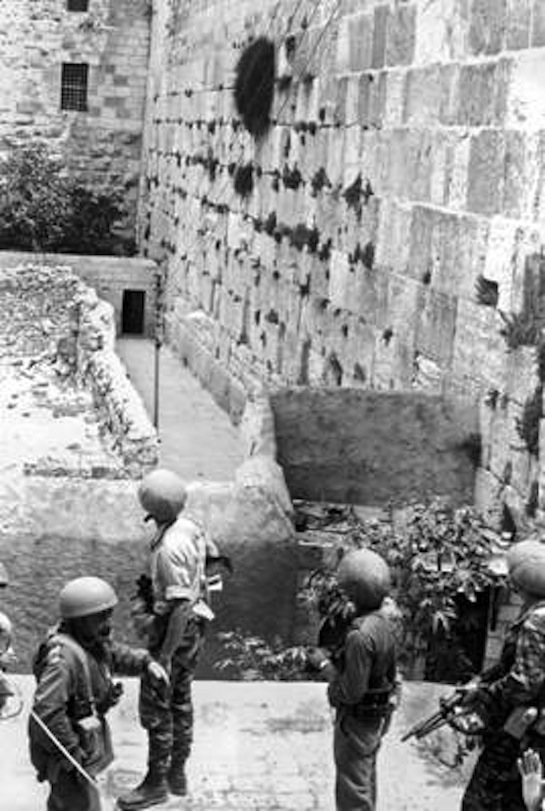By the rivers of Babylon
There we sat down and yea, we wept
When we remembered Zion.
To understand contemporary Israel and the emotions present in any discussion of Middle East peace, one needs to grasp the significance of two dates—June 7 and the Ninth of Av.
Twice in history, 655 years apart, the armies of Israel were defeated by world empires—first by the Babylonians under Nebuchadnezzar in 587 B.C., then by the Romans under the future emperor Titus in 70 A.D. Both times the Jewish people were expelled from their ancient home. And both times, on the same calendar day— the ninth of the Hebrew month of Av—the great temple in Jerusalem, Solomon's temple, was razed to the ground.
When Babylon subsequently fell to the Persians, Cyrus the Great permitted the Jews to return to Judea and to rebuild the temple. You may have read about the "Cyrus Cylinder," which has been on display at various museums around the United States recently. Part of this artifact is that very decree.
Six hundred years later, the Romans were not as kind. They burned to the ground the Second Temple (rebuilt by Ezra and Nehemiah in 515 B.C.), cleared the stiff-necked Jews out of the holy land, and left them to scatter in exile among the nations of the earth.
From 70 B.C. to 1948, the Jewish people had no national home. Jews survived in diaspora—as strangers and exiles in the lands of others. Who is the exile? He is the outlander, the alien. The exile is the whipping boy. He is the last allowed aboard the boat and the first thrown over the side.
At the exile’s door are laid inevitably the evils of the society in which he dwells as a supplicant. He becomes the sinister one, the schemer in secret, the conspirator, the dark hand. Against the exile are mounted the seductions of assimilation, the coercions of forced conversion, and eventually the purges and inquisitions, the pogroms, and the programs of extermination that are the fate of those with no home to call their own. This is true of all exiles in all lands in all centuries.
The Jewish people came home in 1948, the year the state of Israel was founded. There was a mighty justice to this, one that the world perceived and mostly approved. However, this repatriation was not yet complete: The Old City of Jerusalem, home of the Jewish people's most sacred sites, remained in the hands of its enemies.
What is the Western Wall? It is not, as many believe, the remains of a wall of Solomon's temple. It is humbler than that. It is part of a retaining wall that supports the mount on which the temple once stood.
The Western Wall is the holiest site of the Jewish people. For 1,900 years no Jew could visit or pray before this wall and say, "This is mine. This stands on land that belongs to me." As Yoram Zamosh, a paratroop company commander who fought in the Six Day War of 1967, wrote:
I remember traveling to Jerusalem when I was sixteen, setting out from the kibbutz on foot, trekking from early in the morning, carrying only a jug of water and a few sandwiches.
The year was 1958. The Jordanians held the Old City then. A Jew could not visit the Western Wall or get anywhere near it. Pilgrims would make their way to Mount Zion, a modest elevation outside the Old City walls. There was a flight of stairs that mounted to a platform from which, on tiptoe, you could peer in the direction of the Wall, which was hundreds of meters away. You could not see the wall itself, only a grove of poplars somewhere above it. Signs warned you not to point your finger because Jordanian snipers might mistake it for a rifle and shoot at you.
On June 7, in the emotional climax of that clash and of two millennia of diaspora, Zamosh and his paratroopers were the first to reach the Western Wall.

Credit:
Courtesy of IDF & Defense Establishment Archives, photo by Amos Zuker.
We have returned to the holiest of our holy places, never to part from it again [said Israeli Minister of Defense Moshe Dayan on that day]. To our Arab neighbors, Israel extends the hand of peace, and to peoples of all faiths we guarantee full freedom of worship and of religious rights. We have come, not to conquer the holy places of others, nor to diminish by the slightest measure their religious rights, but to ensure the unity of the city and to live in it with others in harmony.
When contemporary diplomats bandy about such terms as "pre-'67 borders," they may be well served to keep in mind the Ninth of Av—the day that began, in the minds of the Jewish people, their 2,000 year ordeal of exile.
They should also recall June 7, 1967, when that exile came, in its deepest sense, to an end.
The Six Day War changed the Middle East politically, militarily, and economically. All those changes remain keenly significant today.
But the greatest change occurred in the soul of the Jewish people. It was an alteration of emotion, and it cannot be ignored or dismissed by any person or state sincerely seeking peace.